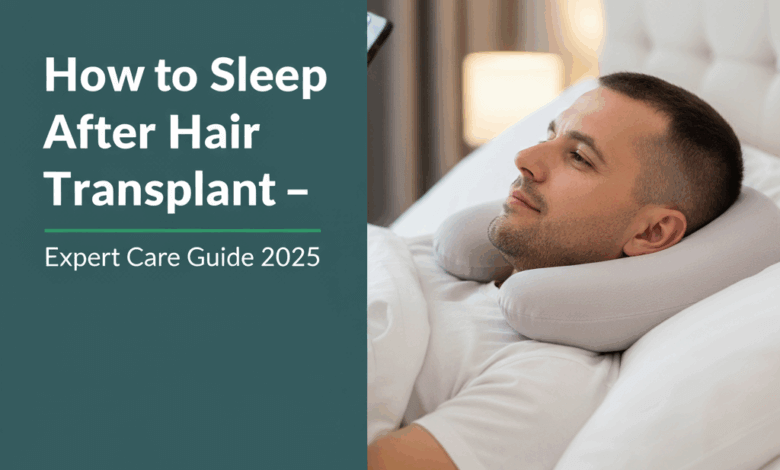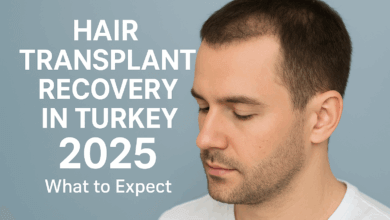How to Sleep After Hair Transplant – Expert Care Guide 2025
Your complete post-hair-transplant sleeping guide — prevent graft damage, swelling, and improve healing with expert-approved techniques.

Introduction
A successful hair transplant doesn’t end when you leave the clinic — how you sleep afterward plays a major role in graft survival, healing, and swelling control.
Improper sleeping positions or friction can dislodge newly implanted follicles, especially in the first few days. This expert guide explains how to sleep safely after your hair transplant, what positions to avoid, and how long you need to maintain precautions.
Why Sleeping Position Matters After Hair Transplant
During a hair transplant (FUE or DHI), thousands of tiny grafts are placed into micro-channels. These grafts remain fragile for 5–7 days until they securely attach to the scalp’s blood supply.
Incorrect sleeping posture or direct pressure can:
-
Cause graft dislodgement
-
Increase swelling (edema) in the forehead or eyes
-
Delay healing and blood circulation
-
Lead to infection due to scalp friction
How to Sleep Safely After Hair Transplant
🧠 1. Sleep With Head Elevated (30–45° Angle)
For the first 7 nights, sleep on your back with your head elevated using 2–3 pillows or a recliner chair.
This position prevents swelling and avoids contact between grafts and the pillow.
💡 Tip: Use a travel neck pillow to keep your head stable and prevent accidental rolling.
🛏️ 2. Avoid Sleeping on Stomach or Side
Sleeping on your side or stomach may press against implanted grafts, increasing the risk of graft loss or irritation.
Stick to supine (face-up) position during the first week — this ensures maximum graft protection.
🧴 3. Use a Clean, Soft Pillow Cover
Change pillow covers daily for at least a week. Use silk or satin fabric to minimize friction and bacterial exposure.
Avoid towels or rough cotton cloths that can stick to the scalp.
💧 4. Manage Swelling with Cold Compress
If forehead swelling occurs, apply a cold compress gently above the eyebrows (never on the grafted area).
Do this for 10 minutes, 3–4 times a day during the first three days.
😴 5. Keep the Room Cool and Clean
Sweating can increase infection risk and discomfort. Maintain room temperature around 20–22°C (68–72°F) and ensure good ventilation.
🚫 6. Avoid Touching or Scratching the Scalp
During sleep, try to avoid any unconscious rubbing. Wearing a loose surgical cap or sterile gauze band can help protect the area from accidental contact.
Sleep Routine Timeline After Hair Transplant
| Days After Surgery | Recommended Sleep Position | Special Notes |
|---|---|---|
| Day 1–3 | Head elevated (45°), on back | Avoid bending or side turning |
| Day 4–7 | Elevated, may start slight recline | Swelling usually subsides |
| Day 8–14 | Flat sleeping possible | Grafts more stable |
| After 2 Weeks | Normal sleep | Continue gentle care |
Scientific Data
-
A 2023 study published in Journal of Cosmetic Dermatology found that patients maintaining head elevation for 5 nights had significantly lower swelling and graft loss rates (below 2%).
-
Posture-related pressure was noted as one of the top preventable causes of early graft failure within the first 72 hours.
Additional Expert Tips
🌙 Use a recliner chair if you move during sleep.
🧴 Avoid applying oils or lotions on donor/graft areas before bed.
📅 Continue elevated sleeping for at least 7 nights for best outcomes.
🚿 Resume hair washing gently only after your surgeon’s approval (typically 48–72 hours).
Common Mistakes to Avoid
❌ Sleeping flat on your back from Day 1
❌ Using too soft pillows (can trap sweat)
❌ Applying ice directly to grafts
❌ Taking sleeping pills without medical advice
❌ Wearing tight headwear while sleeping
When Can You Resume Normal Sleep?
By Day 10–14, most grafts are securely anchored. You can gradually resume normal sleeping posture as long as there’s no pain, swelling, or scabbing.
However, avoid rough contact or vigorous rubbing for at least 3 weeks to ensure permanent graft take.
Conclusion
Sleep may seem trivial, but it’s a critical part of post-transplant recovery.
Maintaining proper elevation and care for just one week can significantly improve graft survival rates and final density.
Following these sleep and aftercare tips ensures your newly transplanted hair thrives naturally — and you wake up every day one step closer to fuller, permanent results.





